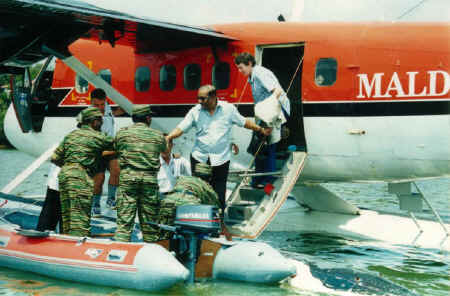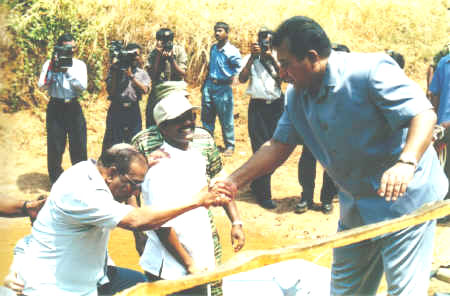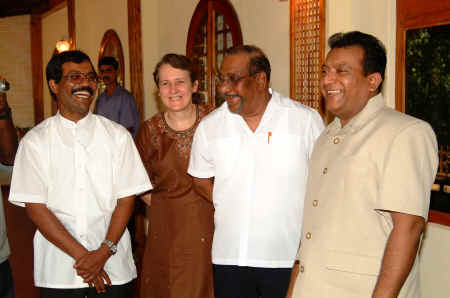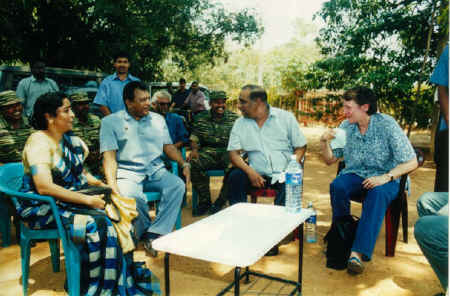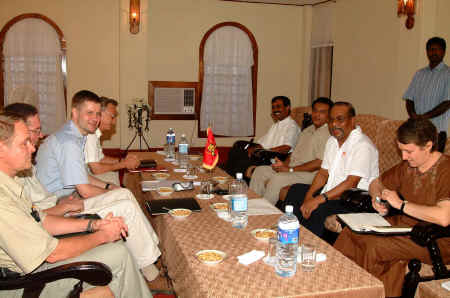The Return of BalasinghamBy D.B.S. Jeyaraj“The
woods are lovely, dark and deep, But I have promises to keep,
|
|||
|
The date, 25th March, is significant in the history of the Tamil militant struggle. The sensational Neervely robbery took place on that day 21 years ago. A van taking money from suburban People’s Bank branches to the head office in Jaffna was ambushed at Neervely on the Point Pedro road. A cool 81 lakhs of rupees was seized. The Neervely robbery was the last act done unitedly by the LTTE and Tamil Eelam Liberation Organization. Among those involved were the legendary Thangathurai, Kuttimani, Sri Sabaratnam and of course Velupillai Prabakharan. Interestingly this was the last action of such type in which the Tiger leader participated. Monday March 25, this year [2002] was a day of jubilation for the Liberation Tigers of Tamil Eelam. Their political strategist, chief negotiator and theoretician Anton Stanislaus Balasingham and his Australian born wife Adele Anne were scheduled to return that day. Balasingham and wife referred to fondly by LTTE cadres as ‘Bala Annai’ and ‘Aunty’ respectively were returning to ‘Tamil Eelam’ after an absence of three years and sixty-one days. Welcoming archesAccording to a radio commentary in the London based International Broadcasting Corporation, the town of Kilinochchi had adopted a festive air (vizghakkolam) for the occasion. Conspicuous among the posters and decorations were two welcoming arches interwoven with roses. It was exactly 10. 38 am on March, 25, that a Canadian made De Havilland DHC-6 Twin Otter sea plane landed on an unusual ‘aerodrome’ in Kilinochchi district – the irrigation reservoir at Iranaimadhu. Situated to the south of Kilinochchi town and north of Kokkavil it is the second largest tank in the northern province. Only the Kattukkaraikulam or Giant’s tank in Mannar is bigger. The original Mahaweli diversion project envisaged a trans-basin canal scheme in which the final destination of diverted waters was to be Iranaimadhu. The accelerated Mahaweli scheme jettisoned this idea. It was on this tank that the seaplane carrying the Balasinghams landed. The landing was on a deep stretch of the waterscape near the Perunkaalvaai or greater canal side. The seaplane belonged to a Danish firm and was in use commercially as a Maldivian Air-Taxi. It had started off from the Maldivian capital of Male that morning. There were five occupants namely the Balasinghams, two pilots of Canadian nationality and the first secretary of the Norwegian Embassy in Colombo, Tomas Strangland. Even as the Seaplane ‘taxied’ to a halt at the Iranaimadhu a sea Tiger inland craft set sail towards it. Sea Tigers Special Commander Soosai was at the helm with three other senior Tiger leaders on board. LTTE Political Wing Chief Thamilchelvan, LTTE Police Chief Nadesan and Thamilendhi the senior official in charge of Tiger finances accompanied Soosai to the plane. It was a poignant moment for Soosai and the Balasinghams. In 1999 on January 23, Soosai had piloted a Sea Tiger boat across the choppy seas of Mullaitheevu carrying the Balasinghams to a LTTE vessel in deep sea and bade farewell. Now he was gliding smoothly on the tranquil waters of Iranaimadhu to welcome them back. The boat returned swiftly to the shores of Iranaimadhu where LTTE leader Velupillai Pirapaharan and wife Mathivathany were waiting to receive ‘Bala Annai’ and ‘aunty’ personally. As it reached the lake bank Pirapaharan went personally up to the boat and extended a hand in an affectionate gesture to Balasingham and helped him to clamber out. Then came an emotional reunion between the Tiger leader and his senior adviser. A number of senior LTTE leaders including Bhanu and Theepan were also at hand to welcome the Balasinghams back. The entourage then returned to the LTTE office at Skanthapuram in Kilinochchi where Balasingham underwent a quick medical scrutiny. After a brief private discussion with the Balasinghams, Pirapaharan and Mathivathany departed from the LTTE office. Thereafter Balasingham and Thamilchelvan had a short discussion. Then came a formal luncheon at 12.30 pm with a visiting Norwegian delegation including Norwegian Envoy in Colombo Jon Westborg, Norwegian special adviser to the foreign minister, Erik Solheim and the Monitoring Mission head Trond Furhovde. Vegetable delicacyBoth Westborg and Solheim had been in the Maldives to send off Balasingham that morning. They returned to Colombo by plane from Male and then proceeded to Kilinochchi by Air Force helicopter. After lunch Balasingham and Thamilchelvan entered into a lengthy discussion with the Norwegians till evening. The physically but not mentally tired Balasingham then retired for a short nap to relieve himself of fatigue. The night saw Anton and Adele Balasingham being entertained for dinner by Velupillai and Mathivathany Pirapaharan. An overjoyed LTTE leader had personally cooked a few special dishes for the occasion including a special vegetable delicacy for the Vegan Adele Anne. Thereafter Pirapaharan and Balasingham entered into a one to one meeting to discuss political matters, which according to LTTE circles extended into midnight. This discussion though the first face-to-face meeting between both in three years, is certainly not going to be the last. It was for this face-to-face confidential discussion with Pirapaharan that Balasingham had undertaken this hazardous journey. Although Balasingham had been in contact with Pirapaharan via telephone, facsimile, electronic mail and special courier it was imperative that a direct meeting had to take place if the peace process was to be taken forward meaningfully. It is widely acknowledged that Balasingham residing in London had played a crucial and pivotal role in the events leading to a ceasefire. It was now necessary for consultations to take place between Pirapaharan and Balasingham for the ceasefire to be consolidated and negotiations to proceed further. The importance of Balasingham’s role in the peace process and the necessity for him to hold discussions with Pirapaharan is fully appreciated by the international community backing the peace process. Norway as intermediary was fully aware of this and hence its unorthodox efforts to facilitate Balasingham’s arrival in Sri Lanka. The delicate state of his health affecting travel and security concerns complicated the issue further. If New Delhi had acceded to requests that Balasingham be permitted to relocate to Chennai and that talks be held in a South Indian city, logistical problems could have been surmounted with less difficulty. The fact that the present United National Front government led by Ranil Wickremesinghe was cooperative on this issue made things much easier for Oslo. The twin problems related to Balasingham’s return to the northern mainland of the Wanni were health and security. Recovering from a kidney transplant and coronary and diabetic conditions the 64-year-old Tiger ideologue could not travel distances at a stretch. He also required medical attention at short notice. The security aspect was over possible attack being directed against him by Sinhala hard-liners and even rogue elements within the armed forces. The discovery of the Athurugiriya arsenal and the rebellious attitude towards observing ceasefire conditions by sections of the armed forces in the east and Jaffna peninsula added much credence to these concerns. So travel to the Wanni via. Colombo was ruled out. The vociferous reaction to Balasingham’s return by Sinhala hard-liners demonstrates that his security would indeed have been threatened had the route been through Katunayake. The Norwegians to whom Balasingham had entrusted the responsibility of getting him back to the Wanni devised a careful plan taking several factors into account. Speaking to a Tamil journalist on the eve of his departure from London, Balasingham was in a pensive, emotional mood. Recollecting the journey he had undertaken three years ago in ill health to reach the west the LTTE chief negotiator said that he had not expected to survive. “When I left I thought that I will never see my beloved homeland again”, he said. Now he was on the verge of another journey back to his motherland but made relatively less perilous by the concerned care of Norway. Overnight stayThe Balasinghams left London on Friday March 22. Three Norwegian officials including Erik Solheim accompanied them on the first leg of the journey to Dubai. Unable to travel long distances at a stretch Balasingham broke journey there to rest for several hours. Thereafter, Erik Solheim the special Norwegian peace envoy left for Colombo. The contingent then traveled to the Maldives to the south of Sri Lanka. They reached the islands in the early hours of Sunday March 24, morning. Balasingham had a brief medical test and found he was all right. The travelers stayed overnight at the Airport Hotel on Hululle Island and were provided security by the Maldivian national security service. Norwegian Ambassador Westborg and First Secretary Strangland went to Male on Sunday night to meet Balasingham. Solheim who reached Colombo on Sunday also accompanied them. Prior to their departure the Norwegian Ambassador and Solheim had met Prime Minister Ranil Wickremesinghe and some other senior ministers. Wickremesinghe incidentally celebrated his 54th birthday on that date. Wickremesinghe to his credit was extremely receptive and flexible to Norwegian efforts in getting Balasingham back. The diplomats were empowered officially to attend to certain immigration requirements, as Balasingham was not scheduled to arrive at any accredited port of entry in Sri Lanka. The Norwegians took with official approval an immigration seal used to stamp passports at the point of entry. The port of entry in the seal was that of Talaimannar the closest entry point to Iranaimadhu. Tank of IranaimadhuTalaimannar the official port of entry for travelers coming by ferry from India has not been utilised for such purposes in recent times. After duly completing necessary paperwork in Male the party took off in the sea-plane. The British passport of Anton and Australian passport of Adele Balasingham were stamped formally when the seaplane landed at Iranaimadhu by Strangland. Only the inscription Talaimannar was crossed out and substituted with Iranaimadhu with due endorsing signature. Thus the inland tank of Iranaimadhu made history by becoming the first accredited interior port of entry in the island’s history. Thus the Norwegians pulled off the triumphant return of Balasingham safe and sound to the Wanni. The return of Balasingham was a joyful event for the LTTE for more reasons than one. When the Tigers bade farewell to Balasingham on January 23, 1999 the uppermost thought prevailing among most members was that of a permanent adieu and not temporary au revoir. Such was the deteriorating state of his health. Yet the man had pulled through and thanks to a surgical kidney transplant in Oslo was now back. In pleasant irony the LTTE supremo and senior leaders who saw him off by ship off the Mullaitheevu coast were now able to welcome him back at Iranaimadhu. The Iranaimadhu factor itself was significant. The Norwegians had arranged this as point of entry out of security considerations as every airport in Sri Lanka has a strong military presence in immediate vicinity and therefore posed a potential security threat to the LTTE at this point of time. Nevertheless the utilisation of Iranaimadhu has thrown open wide possibilities of air travel to and from LTTE controlled areas. The adoption of Iranaimadhu as landing point could not have been possible without the LTTE being sure of its viability and safety. Pirapaharan would have never risked Balasingham’s life if he was not confident about Iranaimadhu’s potential. This therefore reinforces earlier reports of the LTTE’s nascent air wing known as Vaanpuligal or air Tigers. LTTE Air WingThe LTTE air-wing founded by Col. Shankar assassinated by a deep penetration killer squad on September 26, 2001 at Oddusuddan has so far not fulfilled expectations. Test flights of micro-lite aircraft gliders have been conducted. Several cadres obtained specialised pilot and aeronautical training experience abroad. An airstrip was set up at Olumadhu. It was also reported once that a helicopter had strewn flowers from the air at a Great Hero’s Day celebration at Mulliyawalai. There were also reports of seaplanes landing and taking off from Iranaimadhu in Kilinochchi, Nandhikkadal at Mullaitheevu and Kattukkaraikulam in Mannar. Tamil civilians themselves had been warned to keep away from a particular side of Iranaimadhu tank. Several trees in the area had also been chopped down and waters cleared. Whatever the outcome of the LTTE’s experiments with aviation the use of Iranaimadhu for Balasingham’s return demonstrates that it has been tried and tested already for such use. Balasingham’s return via Iranaimadhu therefore shows that the LTTE has reached another milestone in its development. It has for the first time publicly got an aircraft to land officially in a freshwater lake in territory controlled by it. This throws open many possibilities in the future and it is indeed fortunate for the state that a ceasefire is in progress. The advent of the ceasefire itself is a premier factor contributing to the rapturous welcome afforded to Balasingham. It is realised fully well that he was the driving force behind it. It was Balasingham who helped sustain the peace process in the face of systematic obstruction and sabotage unleashed by the Kumaratunga - Kadirgamar duo. It is also acknowledged that Balasingham’s return however temporary it may be, will certainly impel the process forward. Already such signs are visible. This explains the sensitive fine-tuning of Balasingham’s return to the Wanni and the tumultuous welcome given to him and wife Adele Anne. Courtesy: The Sunday Leader [31 March 2002] |
|||
